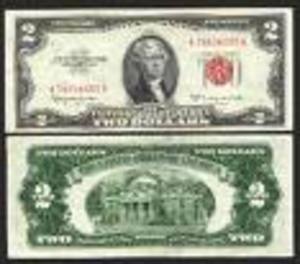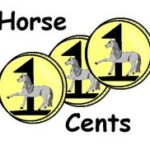Maybe the speculation about a possible U.S. $2 coin is a result of somebody’s contorted thinking that such a coin would embrace “the best of both worlds”, i.e.: the short-lived U.S. 2-cent piece (1864-1873) or the more recent $2 bills. Hey, why not? It worked in Canada, didn’t it?
As a standard size U.S. curency note, $2 bills first saw the light of day in 1927 and though most people rarely see the note, it still popularly used at horse racetracks, where most bets are $2 bets, hence the increased usage. Actually, first officially issued the $2 bill in July of 1862 as an United States Note with a portrait of Alexander Hamilton.
In spite of its relatively low value, the two dollar banknote is one of the most rarely-seen denominations of U.S. currency. This is due to the low production of the note; approximately .5% of all U.S. notes produced are $2 bills. Because of its rarity, many Americans remain remarkably superstitious about spending it, which further decreases its circulation. Few cash registers and money-handling machinery (such as vending machines) accommodate it and it is so rare that many Americans have never come in possession of one.
After the aforesaid Alexander Hamilton $2 bill, the next $2 note was in 1869 featured the now familiar portrait of Thomas Jefferson painted by American artist Gilbert Stuart. The large-sized (7.375″ x 3.125″) $2 bill was also issued as a Silver Certificate, Federal Reserve Bank Note, Treasury or Coin Note, and as a National Bank Note.
In 1929, when all U.S. currency was changed to its current size (6.125″ x 2.625″), the $2 bill was kept as a United States Note. Notes were issued in series of 1928, 1953, and 1963. The front of the bill featured a cropped version of Thomas Jefferson’s portrait that had been on previous $2 bills. The back of the bill featured Jefferson’s home, the Monticello. These $2 bills were officially discontinued in August of 1966.
In 1976, the Treasury Department reintroduced the bill as a cost-saving measure. As part of the United States Bicentennial celebration, the note was redesigned and issued as a Federal Reserve Note. The front featured the same portrait of Jefferson, a green instead of red seal and serial numbers, and the picture of Monticello on the back was replaced with an engraved rendition of John Trumbull’s painting, “The Declaration of Independence”. First day issues of the new bicentennial $2 bills could be taken to a post office and stamped with the date 13 April 1976. It was the anniversary of Jefferson’s birthday. In all, 590,720,000 notes from the 1976 series were printed. The bills proved extremely unpopular and printing was stopped.
Many give as a reason for its failure that its value is redundant, being only twice the value of the $1. However, the fact that the $2 bill (and later coin) succeeded in Canada offers a potential counterpoint to this. Also, one could have used the redundancy argument to predict that the dime (being worth two nickels) and the $10 (being worth two $5 bills) would likewise be failures, but this has not been the case. Other, more colorful, stories about the reasons for its failure exist.
In 1996 and 1997, 153,600,000 bills were printed [1] as Series 1995 with the signatures of Robert Rubin and Mary Ellen Withrow. In 2004, 121,600,000 of the newest $2 bills, Series 2003, were printed bearing the signatures of John W. Snow and Rosario Marin. Both of these issues have the same design as the Series 1976 $2 bill.
An amusing and perhaps apocryphal story regarding two dollar bills being paid to military servicemen has circulated intermittently in American public consciousness over the years. This story being constantly retold reflects how some Americans view the two dollar bill.
The basic premise is as follows: a coastal town somewhere has a business district that, while successful financially, is plagued by uncouth Navy servicemen on shore leave. They come in, make a ruckus, get drunk, and generally upset the town’s otherwise quiet atmosphere. The locals, who do not appreciate the intrusion, finally get together and lodge a formal complaint with the Navy.
The Navy, in response, decides to teach the arrogant town a lesson in economics and pays a substantial portion of its
servicemen’s following months’ salary in two dollar bills. When the sailors subsequently descend on the town to spend their wages, the local businesses are inundated with two dollar bills; in fact, they realize that they have more two dollar bills than anything else, which certainly grabs their attention.
The message, of course, is that the Navy servicemen on shore leave might very well be boorish and intrusive, but the money they spend represents the livelihood of the store owners responsible for the letter of complaint. Needless to say, they were more patient with the sailors thenceforth.
The fact that this tactic worked, of course, is entirely a result of the two dollar bill’s rarity. One dollar bills or five dollar bills would not have been so readily noticed. Two dollar bills drive the point home; there is no way they can be ignored, given that they are almost never seen.
Now about the U.S. 2-cent pieces. Most people don’t even know they existed. They were issued as emergency curency near the end of the Civil War in an effort to compensate for the shortage of wartime metals, namely copper.
The 2-cent piece was introduced during the bloodiest year of the American Civil War between the Northern and Southern states. The coin is best remembered as being the first to carry the inscription “In God We Trust” inscribed on a banner above the Union Shield. It was suggested by a minister as a way to help Union morale. Some reports at the time said the coin was “immensely popular,” but its later track record, and short life, suggests such plaudits were the work of Lincoln-era spin doctors at work. The coin was designed by: James B. Longacre, the same fellow who designed the popular Indian Head Cent (1859-1909) and various other U.S. issues.
President Lincoln approved inclusion of the religious sentiment and the coin was authorized by the Act of April 22, 1864, which provided for a bronze “Two Cent Piece” weighing of 96 grains. Circulation, or business strikes, were minted from 1864 to 1872 and a total of only 1,100 proof specimens were struck in 1873. The obverse shows a shield topped by a ribbon containing the motto. The reverse states simply: “United States of America” and the value within a wreath. It was made of bronze.
A different story is documented on the Snopes website. In the story, a Taco Bell patron attempts to pay for a burrito with a two dollar bill. The cashier, and the store manager all refuse to accept it as valid US currency thinking there is no such thing a as a $2 bill. When the patron insists on paying with it, they call security who then explains that $2 bills are valid US currency.
More recently, in February, 2005, an annoyed patron at one of the Best Buy chain stores was attempting to pay for an electronics installation that had been originally promised to be free, with 57 $2 bills. The young, not too bright cashier, who had never seen or heard of this denomination of her country’s currency, refused to accept them and marked them as counterfeit. The cashier then called the police and the patron was handcuffed by an equally ignorant policeman. Eventually a U.S. Secret Service agent arrived and told the red-faced policeman and cashier, and several other store employes, that $2 bills were legitimate U.S. curency. He paused for a moment then asked the collected group if any had ever seen a John F. Kennedy Half Dollar?
“What’s a half dollar?” one of the never-to-be-Rhodes Scholars asked.
Reference:
- Copyright © 2005 by Timothy B. Benford, for publication in Canadian Coin News





